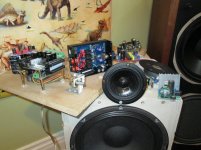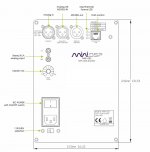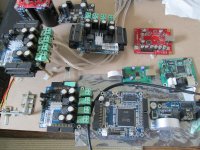Dr. Dan Russel has a collection of nice animations of loudspeaker radiation etc. basics
Dan Russell's Acoustics and Vibration Animations
Lots of cool animations there.
David
The only thing they test into the simulated load is the frequency response of the amplifier itself, ie really to see how amplifiers with higher than average output impedances affect the frequency response. They do all their other testing into purely resistive dummy loads.
Yes, the testing they do that's actually audibly relevant is into the simulated load. The rest of it is much less important. Basically irrelevant for any amp a thoughtful person would consider.
IMO, the ideal published amp review would be FR into a simulated load, S/N, a Powercube, and Dr. Geddes' crossover distortion test.
It isn't hard to infer how an amplifier is going to perform into a horrible loudspeaker load (in terms of distortion) ***
But (nonlinear) distortion in amps is rarely an issue. Frequency response, with many Class D amps, is.
How much does that affect the frequency response of usual speakers?
Depends on the amp and impedance curve of the speaker. With some pairings you'll find differences that would be audible in a well-conducted blind test. With others you won't. IMO it's better to pick amps where one knows there will be no FR errors caused by interaction of loudspeakers and amp no matter what (reasonable) speakers one hooks to the amp, which is why I gravitate towards load-invariant Class D and standard Class AB.
Thus, if you do your XO actively before the amp, it is a non-issue. The LC filter essentially presents no distortion in amplitude or phase is used as an active XO amp.
Of course, nobody claimed otherwise. The issue I brought up was FR nonlinearities caused by the interaction of the amp with a complex load. However, while active filtering is justly gaining popularity - thanks to the reasonable cost, intuitive GUI, and high performance of miniDSP's parts more than anything else IMO - there are still plenty of people who use passive crossovers. And as long as one can get the appropriate transfer function, contra Deward's silly rant there's no material disadvantage to a passive filter.
Furthermore, for active systems with multiple amps, features such as 12V triggers or auto on/standby circuits become much more important. Enjoying music should IMO be no more difficult than pressing the relevant activity button on one's universal remote. And leaving stuff on all the time is not a moral answer.
Last edited:
Depends on the amp and impedance curve of the speaker. With some pairings you'll find differences that would be audible in a well-conducted blind test. With others you won't. IMO it's better to pick amps where one knows there will be no FR errors caused by interaction of loudspeakers and amp no matter what (reasonable) speakers one hooks to the amp, which is why I gravitate towards load-invariant Class D and standard Class AB.
How do I identify whether a specific class D amp is load-invariant?
They will make a big deal of it in the advertising copy.How do I identify whether a specific class D amp is load-invariant?
Otherwise it's pretty much a non-issue, except above 10kHz and with loudspeakers/crossovers that do not maintain a flat impedance curve or are otherwise mismatched to the amplifier output filter. It's not an issue at all for any even marginally competent DIYer.
How do I identify whether a specific class D amp is load-invariant?
They will make a big deal of it in the advertising copy.
...
Not necessarily:
"closed loop power stage architecture"
...
" a higher Power Supply Rejection Ratio (PSRR) of up to 60dB, lessens the impact of power supply noise on audio quality. The higher damping factor of closed loop power stage also provides better control of speaker cone movement, especially at low frequency"

miniAMP | MiniDSP
View attachment Product%20Brief-MiniAMP.pdf
Last edited:
They will make a big deal of it in the advertising copy.
Otherwise it's pretty much a non-issue, except above 10kHz and with loudspeakers/crossovers that do not maintain a flat impedance curve or are otherwise mismatched to the amplifier output filter. It's not an issue at all for any even marginally competent DIYer.
Just because it's not ns issue for your specific preferences doesn't mean it's not an issue at all, of course. Your "except" clause covers most of the actual universe of home loudspeakers, off the peg and DIY!
That amp is not load invariant. And FYI the amp chip there is also used in the Griffin 20, a 100 dollar dac/amp with a dock for a MacBook power supply on top. (I know because I've taken my 20 apart.)
Now, when used as intended (piggybacked onto a 2x4 miniDSP to drive a small active 2-way) it doesn't really matter.
Are there any of these class-D modules up in the 50 watts / channel range? Or are they all low wattage because of supply limitations?
If one used these amps inside of the speaker, any of these frequency response issues due to a finite output impedance could easily be compensated for in the crossover. But 20 watts is just too little for a serious system.
If one used these amps inside of the speaker, any of these frequency response issues due to a finite output impedance could easily be compensated for in the crossover. But 20 watts is just too little for a serious system.
The IRS2092 based amps (which I use) easily do that, and more, and they're quite inexpensive. They do, however, require something more than a wall wart for power . . .Are there any of these class-D modules up in the 50 watts / channel range?
Yes, the testing they do that's actually audibly relevant is into the simulated load. The rest of it is much less important. Basically irrelevant for any amp a thoughtful person would consider.
The only commercial amplifiers that I would consider are the ones that have exceptional distortion performance.
IMO, the ideal published amp review would be FR into a simulated load, S/N, a Powercube, and Dr. Geddes' crossover distortion test.
Suit yourself. I see the pinnacle of high performance amplifier design to be achieving very low distortion, especially at high frequencies, whilst keeping the thing unconditionally stable.
But (nonlinear) distortion in amps is rarely an issue. Frequency response, with many Class D amps, is.
Again this is your personal view point. Higher distortion than their should be, and certain FFT patterns in the distortion performance help to illuminate issues in amplifier implementation that one should not have to put up with. Flat frequency response is an obvious requirement, but loads of valve amplifiers also show terrible linearity in this respect and loads of people love how they sound. A class D amplifiers rising, or falling response, is easy enough to correct for though. I agree that output filter inclusive feedback should be what every class D amplifier designer should be striving for, but it seems harder to achieve than one might think.
Are there any of these class-D modules up in the 50 watts / channel range? Or are they all low wattage because of supply limitations?
If one used these amps inside of the speaker, any of these frequency response issues due to a finite output impedance could easily be compensated for in the crossover. But 20 watts is just too little for a serious system.
PWR-ICE125 | MiniDSP

analog in (pro and consumer)
digital in (pro and consumer)
2 x 125 W (one ch can atten 16db for tweet)
DSP
network/wifi
pretty cheap too!
http://www.minidsp.com/images/documents/Product Brief-PWR-ICE125.pdf
PS 2 x 250 W
http://www.minidsp.com/products/plate-amplifiers/pwr-ice250
Last edited:
They will make a big deal of it in the advertising copy.
Otherwise it's pretty much a non-issue, except above 10kHz and with loudspeakers/crossovers that do not maintain a flat impedance curve or are otherwise mismatched to the amplifier output filter. It's not an issue at all for any even marginally competent DIYer.
Don't assume I'm a member of that group. So how would I go forward testing a class D amp? Measure the magnitude response for different fixed loads at the output?
The PWR-ICE125 which is in reality an ICEPower ASX2 module is quite nice but it's not transparent in the treble area. It sounds a little tube like with added warmth.
Hypex Ncore is the very best class D amp and probably followed by Hypex UcD HG with HxR.
https://www.hypexshop.com/DetailServlet?detailID=4466
https://www.hypexshop.com/DetailServlet?detailID=2287
Hypex Ncore is the very best class D amp and probably followed by Hypex UcD HG with HxR.
https://www.hypexshop.com/DetailServlet?detailID=4466
https://www.hypexshop.com/DetailServlet?detailID=2287
The only commercial amplifiers that I would consider are the ones that have exceptional distortion performance.
That's fine. I don't pay attention to amp THD because I've never seen a blind test that showed it to matter, at least at levels found in competently-designed amps. (I'm sure there are a few "high end" train wrecks out there with audible levels of distortion.) Show me such a test and I'll change my mind.
Again this is your personal view point.
Sure, whatever. Unlike many here, I don't attach any romance to mere electronics boxes. I'm more reality based. Amps are black boxes to me. I care about what has been shown in reliable testing to be audible (like, say, frequency response), and couldn't care less about things that have not been shown to be audible in reliable testing. Sonically transparent is good enough for me.
Flat frequency response is an obvious requirement, but loads of valve amplifiers also show terrible linearity in this respect and loads of people love how they sound.
People also love how 7" 2-ways with polar maps that look like mushroom clouds sound, so...
PWR-ICE125 | MiniDSP
View attachment 434162
analog in (pro and consumer)
digital in (pro and consumer)
2 x 125 W (one ch can atten 16db for tweet)
DSP
network/wifi
pretty cheap too!
http://www.minidsp.com/images/documents/Product Brief-PWR-ICE125.pdf ***
When one considers that the cheapest an end user can usually get a naked 125ASX2 (between $200 and $250 each), the miniDSP package looks like an even better deal. The only flaw of the PWR-ICE is that it doesn't have a 12V trigger (the competing Hypex model has one) or signal-sensing turn-on/standby, though they claim signal-sensing on/standby could be implemented with new firmware. They have a good track record of following through on such words. For instance, they promised Mac native control software for these amps from the beginning, and a few weeks ago they released it.
*** how would I go forward testing a class D amp? Measure the magnitude response for different fixed loads at the output?
IMO, the easiest way is to take a speaker, match voltages between the D amp and any standard AB amp, and measure the FR when the speaker's driven by both amps. That will show if there are frequency response errors caused by the D amp driving those speakers. Just be careful not to move speaker or amp in between runs.
The PWR-ICE125 which is in reality an ICEPower ASX2 module is quite nice but it's not transparent in the treble area. It sounds a little tube like with added warmth.
Incorrect, and the kind of silly nonsense that can emerge when one bases opinions on sighted listening with unmatched levels.
Within four feet of me I have an amp with a single Icepower 125ASX2, an amp with twin Hypex UcD180's modules, a well built AB miniamp, and the aforementioned TI-based Griffin 20. Except for the Griffin 20, they all sound exactly the same into any "normal" speaker, when level matched. Not a damn bit of difference in the treble or anywhere else.
The only ascertainable difference between them is that the 125ASX2 seems happier driving extremely low-Z loads than the other two. (Remember that the Icepower PS and amp are on one board, whereas the Hypex modules are amp section only. I've noticed that Hypex-based amps often use separate power supplies that are undersized for extreme loads but just fine in normal use.)
FWIW, here are measurements of a commercial product using the 125ASX2. Not exactly tube-like performance.
I've owned the 125ASX2 modules and did a direct test to Hypex 400HG with HxR where levels where more or less the exact same (not within 0.1 dB though). I had no problem hearing the added warmth 125ASX2 gave and difference was more then subtle. 125ASX2 was also (for unknown reason to me) leaner somewhere in the bass but this difference here was much smaller and I would open to be wrong in that area.
I know another who experienced the exact same as me comparing the same amps. He normally level matches 100% when he tests and often blindtests as well. Whether he did this time is unknown to me.
You can believe whatever you want Pallas. I know what I've experienced and the difference was so clearly audible that I personally stick to it despite not being a blindtest. There are other times, especially when comparing good DACs, where I feel they sound is so similar that I don't trust the difference I experience as being real or imaginary.
It's difficult to know whatever the measurements are showing is the exact same as my 125ASX2 amp. Bel Canto may have tweaked it. I don't know of the IcePower ASX2 modules have been modified over time either, like other IcePower modules have been over the years. I bought mine in the very beginning, many years ago. Either way, I assume the difference I experienced would lie somewhere in the distorion figures.
As a sidenote but perhaps with little relevance. I have noticed something when testing electronics over the years. If the room has major acoustic issues, the differences in electronics can to a large degree be buried beneath this and one has a hard time distuinguishing.
I know another who experienced the exact same as me comparing the same amps. He normally level matches 100% when he tests and often blindtests as well. Whether he did this time is unknown to me.
You can believe whatever you want Pallas. I know what I've experienced and the difference was so clearly audible that I personally stick to it despite not being a blindtest. There are other times, especially when comparing good DACs, where I feel they sound is so similar that I don't trust the difference I experience as being real or imaginary.
It's difficult to know whatever the measurements are showing is the exact same as my 125ASX2 amp. Bel Canto may have tweaked it. I don't know of the IcePower ASX2 modules have been modified over time either, like other IcePower modules have been over the years. I bought mine in the very beginning, many years ago. Either way, I assume the difference I experienced would lie somewhere in the distorion figures.
As a sidenote but perhaps with little relevance. I have noticed something when testing electronics over the years. If the room has major acoustic issues, the differences in electronics can to a large degree be buried beneath this and one has a hard time distuinguishing.
Don't want to turn this thread into a class D discussion but how is this one?
Product Lines > Parasound Z > Zamp•Quattro Four Channel Dual Zone Power Amplifier
- 50 watts RMS x 4 @ 8 Ω, all channels driven
- 90 watts RMS x 4 @ 4 Ω, all channels driven
- $600
Product Lines > Parasound Z > Zamp•Quattro Four Channel Dual Zone Power Amplifier
- 50 watts RMS x 4 @ 8 Ω, all channels driven
- 90 watts RMS x 4 @ 4 Ω, all channels driven
- $600
Two vertical 5 unit bessel arrays flanking a central line of two vertical planar tweeters all in dipole configuration.
Not quite
http://www.diyaudio.com/forums/multi-way/260900-2d-dipole-array-cd-follow-up-1-4khz-thread.html
Except that no. 1 clearly states that is not the case. All Griesinger says is that <700 Hz is a factor. He clearly states that >700 Hz is dominant. Your interpretation of no. 3 goes completely against no. 1. I do not think Griesinger wrote these papers as a contradiction - I think that it is your interpretation that is in error.
I see no contradiction. As pointed out earlier No 1. is about localization of real sources while No.3 about localization in stereo. Quite different things. Griesinger himself was surprised by no.2 which went against "common sense".
Would be great to ask Mr. Griesinger himself
1. papers by Griesinger concluding that >700 Hz D/R ratio is key for localization of (real) sources in (large) concert halls. That >700 Hz is important is beyond questioning.
2. papers by the same Griesinger concluding that < 700Hz (and even <400Hz) is easily and sharply located with broadband speech signal (something not uncommonly found in music)
3. same Griesinger concludes that LF vs. HF stereo localization/imaging is screwed up by the room (bass towards the center of the stage and sometimes stretching HF apart) and suggesting one can improve that by EQ-ing the L-R and L+R signals to bring HF and LF localization in coincidence.
What is actually missing is quantitative data about:
- what happens to localization with a broadband signal covering _both_ <700 and >700 Hz. So far, no. 3 above suggests both ranges are equally important.
Unlike many here, I don't attach any romance to mere electronics boxes. I'm more reality based. Amps are black boxes to me. I care about what has been shown in reliable testing to be audible (like, say, frequency response), and couldn't care less about things that have not been shown to be audible in reliable testing. Sonically transparent is good enough for me.

Don't want to turn this thread into a class D discussion but ...
Too late
- Status
- This old topic is closed. If you want to reopen this topic, contact a moderator using the "Report Post" button.
- Home
- Loudspeakers
- Multi-Way
- Why crossover in the 1-4khz range?

